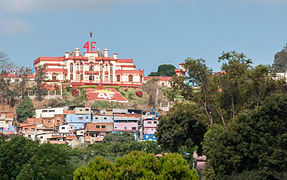23 de Enero
23 de Enero | |
|---|---|
Parish | |
VET) | |
| Website | www |
23 de Enero is a
History
Marcos Pérez Jiménez government
In the early 1950s, under the government of General Marcos Pérez Jiménez a Housing Unit apartments designed by architect Guido Bermúdez on the model of "
In 1966, it was decided to separate 23 de Enero from the Sucre Parish and place it under the "parish" category, keeping the same name of "23 de Enero". The parish has had a history of social struggle since then.[1][2]
Carlos Andrés Pérez government
During the presidency of
Bolivarian government
Since 15 March 2013, the remains of former president Hugo Chávez now rest in the Museum of the Bolivarian Revolution (Cuartel 4 de febrero), also known as the "Montaña Barracks", the very spot where the coup attempt of 1992 was launched.
Geography
It is located northwest of Caracas, nestled in a series of hills, adjacent to the Catia and
Sectors
The parish also has separate sectors such as el Observatorio, La Piedrita, La Silsa, Mirador, El Samán, La Cañada, La zona Central, Monte Piedad, Zona F and others.
Demographics
As of 2009, the population of was 84,650. Most of the area is composed of slums of squatters who have remained in the area since the overthrow of Marcos Pérez Jiménez in 1958.[1][2]
Crime
23 de Enero has a reputation of violence, robbery, kidnapping and drug trafficking.[2] Colectivos such as the Tupamaros occupy the area where they allegedly partake in or combat crime.[1][2] Colectivo members patrol the area thoroughly with some possessing armbands with the Venezuelan flag, firearms and radios.[2] Residents claim that colectivos have reduced crime since they use heavy penalties that were allegedly instilled by former president Hugo Chávez.[2]
Gallery
-
Construction of the complex in 1955.
-
Original plan of the area.
-
The area as seen from Miraflores Palace.
-
Cuartel de la Montaña
References
- ^ a b c d W. Knox, George. "The Tupamaro Gang of Venezuela". National Gang Crime Research Center. Archived from the original on 19 February 2015. Retrieved 9 March 2015.
- ^ a b c d e f g h Torres, Alberto (11 March 2013). "El Temido Barrio 23 de Enero". El Universal. Retrieved 9 March 2015.






